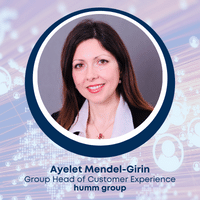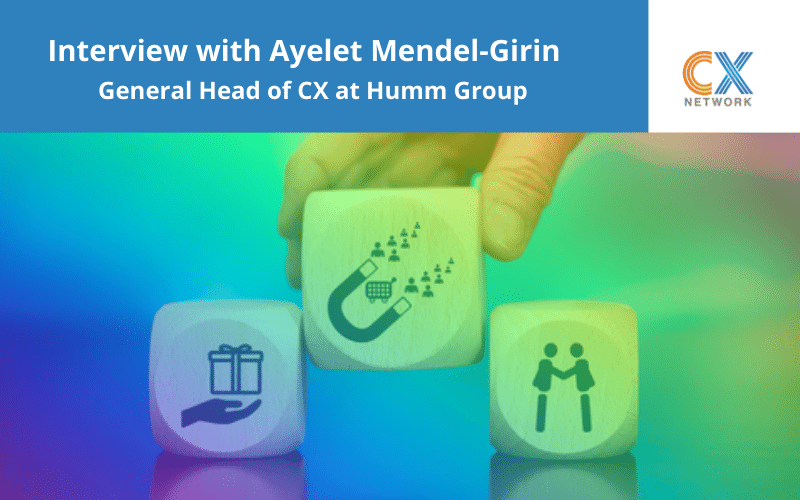Article by Chanice Henry, article first published by CX Network
Ayelet Mendel-Girin, general head of customer experience at Humm Group, discusses the art of emotional engagement when building loyalty winning self-service channels and employee experiences.
Since starting her career as a traditional market researcher, Mendel-Girin has seen the scope of the role expand significantly to include user testing, digital analytics and design thinking practices. These customer-centric skills she acquired have proved valuable in throughout her profession. “The novel synergy between market research, UX and big data helps the business to capture customer journeys more holistically and adopt a truly omnichannel approach.”

Her work at Deloitte involved leading the charge on driving stronger connections between the customer insights and product teams. “Helping the business not just to listen to customer voice, but plan, prioritize and act upon it,” says Mendel-Girin.
Now at Humm group, Mendel-Girin is joined by other customer experience leaders in shifting organizational focus from being preoccupied with pure business metrics (review, cost), to customer and nature focused metrics – such as customer satisfaction, loyalty or environmental impact.
Mendel-Girin notes: “I feel very privileged to be a part of the amazing and fast growing CX community. As they say: [building customer loyalty] is like asking someone on a date, branding is a reason they say ‘yes’, but customer experience is why they marry you and stay with you forever.”
How can companies encourage their customers to shift to self-service?
AM: “In the beginning of the digitalization [era] around 20 years ago both customers and organizations were excited to move to self-serve channels. [However], we are now witnessing a significant decline in consumer satisfaction with these channels, leading to a significant experience gap.
“This gap is a result of poorly built self-serve channels, that stem from companies not fully understanding customer needs and service goals, as well as poor process execution.
“Self-serve channels that customers love address these areas with the following strategic points:
- Firstly, customer journeys are built to capture all customer questions, concerns and needs. These can be functional questions such as – ‘what is your companies’ return policy?’ or emotional ones – ‘can I trust this app with my credit card details?” Companies often focus on the ‘functional’ questions and [neglect the customer’s need for] reassurance, confidence and encouragement.
- The next step after mapping the customer journey is to build a support channel ecosystem. Execution excellence happens when self-serve channels are personal, simple to use and provide the latest information in real– Most customers prefer to use self-serve channels in comfort of their home, at their preferred time, but only if they have confidence they will receive [all the information they require] and in a user-friendly way.
“To achieve that, Humm Group is building a platform ecosystem, such as connecting our contact centre to our CRM system (personalization) and Zendesk (knowledge management system, scripting Q&A in real-time). We also measure [the success of] each self-serve channel integration (e.g ‘was it helpful’?) to improve responses that scored lowest.
“Also, we allow customers to be transferred to a human agent, if necessary. This makes the channel feel less ‘robotic’ and avoids customer frustrations over hitting a dead end.”

How can incorporating Voice of the Customer (VOC) feedback help contact center agents better communicate with customers?
AM: “When working with customers, it’s not only about what you say, but it is also about how your say it.
“Responding to the same customer inquiries every day can be frustrating and emotionally draining for agents. To address that, at Humm Group we set up a monthly cadence with the contact centre and collections team to present VOC insights. It gives our agents a deeper understanding of customer circumstances, their journey with us and why they feel challenged and are complaining about seemingly ‘simple issues’. These monthly discussions create deeper customer empathy, resulting in more patient, courteous service.
“I also showcase the positive feedback, including agent’s names, to lift their spirits and recognize their efforts to go the extra mile for customers.
“As a separate initiative, I run a customer council meeting including the general managers of product, marketing, digital and support. In these catchups we look at the top 10 call centre drivers and agent comments, then we build a plan to resolve the major drivers. These initiatives help contact centre agents feel really empowered, as they make an impact on actual company policy and products. It also helps maintain focus on the same top issues across different teams and resolve key customer pain points more efficiently and holistically.
“The customer council has a Microsoft Teams channel, so if there is an outage or any disruption with our app/website, it’s immediately communicated to the support teams. Then the relevant individuals can add an appropriate messaging to the chat/IVR and prevent agents from being caught off guard, so they know what to tell customers.”

